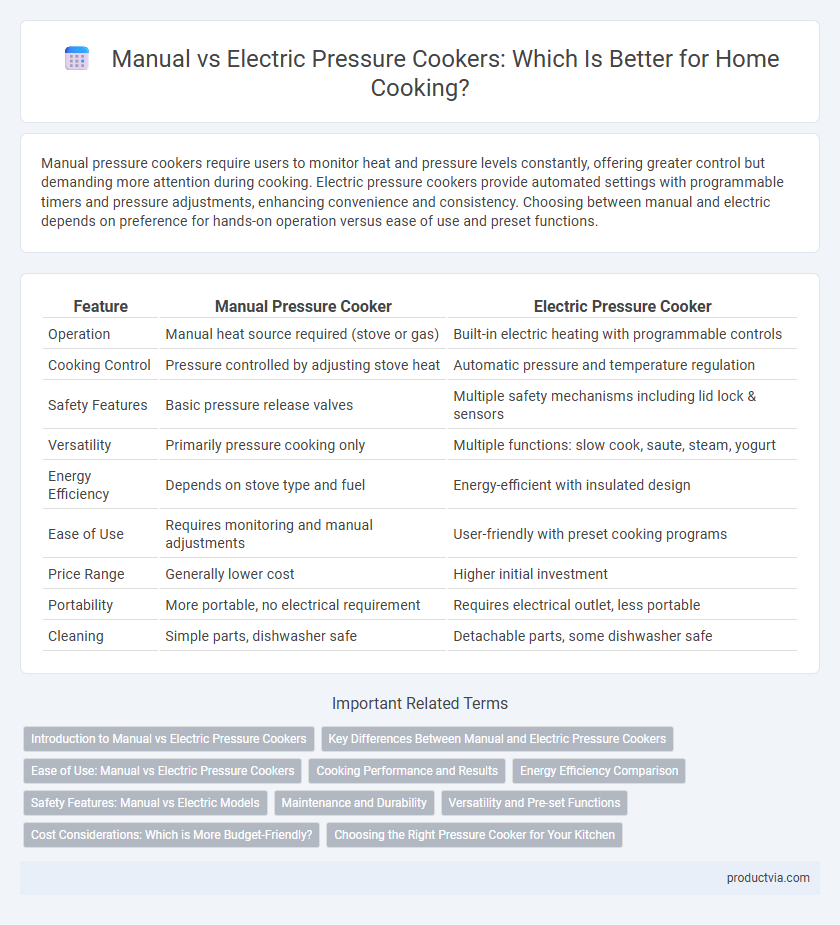Manual pressure cookers require users to monitor heat and pressure levels constantly, offering greater control but demanding more attention during cooking. Electric pressure cookers provide automated settings with programmable timers and pressure adjustments, enhancing convenience and consistency. Choosing between manual and electric depends on preference for hands-on operation versus ease of use and preset functions.
Table of Comparison
| Feature | Manual Pressure Cooker | Electric Pressure Cooker |
|---|---|---|
| Operation | Manual heat source required (stove or gas) | Built-in electric heating with programmable controls |
| Cooking Control | Pressure controlled by adjusting stove heat | Automatic pressure and temperature regulation |
| Safety Features | Basic pressure release valves | Multiple safety mechanisms including lid lock & sensors |
| Versatility | Primarily pressure cooking only | Multiple functions: slow cook, saute, steam, yogurt |
| Energy Efficiency | Depends on stove type and fuel | Energy-efficient with insulated design |
| Ease of Use | Requires monitoring and manual adjustments | User-friendly with preset cooking programs |
| Price Range | Generally lower cost | Higher initial investment |
| Portability | More portable, no electrical requirement | Requires electrical outlet, less portable |
| Cleaning | Simple parts, dishwasher safe | Detachable parts, some dishwasher safe |
Introduction to Manual vs Electric Pressure Cookers
Manual pressure cookers require users to monitor heat and regulate cooking time directly, offering precise control but demanding more attention. Electric pressure cookers feature built-in timers and pressure settings, providing convenience with automated safety mechanisms and multiple cooking programs. Choosing between manual and electric models depends on user preference for hands-on operation or smart, programmable functionality.
Key Differences Between Manual and Electric Pressure Cookers
Manual pressure cookers require direct stove heat control and often feature simple, durable designs with fewer safety mechanisms, offering faster pressure buildup but requiring more user attentiveness. Electric pressure cookers integrate programmable settings, built-in sensors, and automated pressure release systems for precise temperature control and convenience, ideal for multi-function cooking. The key differences lie in operational ease, safety features, and versatility, with electric models providing hands-off cooking and manual variants emphasizing speed and traditional stovetop use.
Ease of Use: Manual vs Electric Pressure Cookers
Electric pressure cookers provide greater ease of use with programmable settings, digital timers, and automatic pressure control, reducing the need for constant monitoring. Manual pressure cookers require more hands-on operation, such as adjusting heat sources and monitoring pressure valves, making them less convenient for beginners. The choice between manual and electric models often depends on user preference for control versus automation in pressure cooking tasks.
Cooking Performance and Results
Manual pressure cookers provide precise control over cooking pressure and time, allowing experienced users to tailor the cooking process for optimal texture and flavor in various dishes. Electric pressure cookers offer automated settings and consistent pressure regulation, resulting in reliable and repeatable cooking outcomes with less monitoring. Both types achieve tender, flavorful meals, but electric models excel in convenience while manual cookers deliver nuanced control for specialized cooking techniques.
Energy Efficiency Comparison
Manual pressure cookers typically consume less energy as they rely on stovetop heat control and maintain pressure through a sealed environment, leading to faster cooking times. Electric pressure cookers incorporate programmable settings and insulation that optimize energy usage by maintaining consistent pressure and temperature more precisely. Studies highlight that electric models can reduce energy consumption by up to 30% compared to traditional manual cookers during typical cooking cycles.
Safety Features: Manual vs Electric Models
Manual pressure cookers rely on basic safety features such as pressure release valves and locking lids to prevent accidents, but they require careful monitoring to avoid overpressure. Electric pressure cookers incorporate advanced safety mechanisms, including automatic pressure control, temperature sensors, and multiple fail-safe systems that reduce the risk of malfunction or user error. The enhanced safety features in electric models make them more reliable for consistent and secure pressure cooking.
Maintenance and Durability
Manual pressure cookers feature simple mechanical parts, making maintenance straightforward and repairs less costly, while electric pressure cookers contain complex electronic components that may require specialized servicing and software updates. Durability favors manual models due to their robust construction and fewer potential points of failure, whereas electric versions offer enhanced precision but can experience wear on sensors and heating elements over time. Choosing between the two depends on prioritizing long-term reliability and ease of upkeep versus advanced functionality and programmability.
Versatility and Pre-set Functions
Manual pressure cookers offer greater versatility by allowing precise control over cooking time and pressure levels, making them ideal for customized recipes. Electric pressure cookers include pre-set functions tailored for specific dishes, enhancing convenience and reducing the guesswork for consistent results. Choosing between the two depends on whether flexibility or ease of use with automated settings is prioritized.
Cost Considerations: Which is More Budget-Friendly?
Manual pressure cookers generally present a more budget-friendly option, with initial costs significantly lower than electric models, often priced between $30 to $100. Electric pressure cookers, such as the Instant Pot, typically range from $80 to $200, reflecting their advanced features and digital controls. Over time, electricity usage costs for electric cookers may slightly increase operational expenses, whereas manual cookers rely solely on stovetop fuel, influencing overall cost-effectiveness depending on energy prices.
Choosing the Right Pressure Cooker for Your Kitchen
Manual pressure cookers provide precise control over cooking times and pressure levels, making them ideal for experienced users who prefer hands-on operation. Electric pressure cookers offer convenience with programmable settings, safety features, and multi-functionality, suitable for busy kitchens and beginners. Choosing the right pressure cooker depends on your cooking style, desired control, and kitchen space, balancing flexibility with ease of use.
Manual vs electric for pressure cooker operation Infographic

 productvia.com
productvia.com